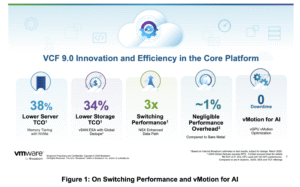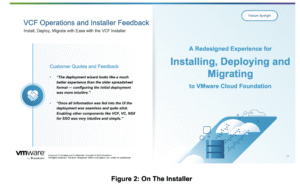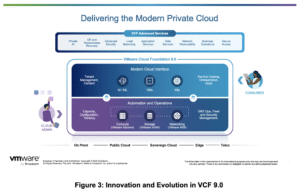
In July 2025, I had the opportunity to participate in a set of Tech Field Day presentations around VMware Cloud Foundation 9.0, the latest release of their private/hybrid cloud platform. I haven’t worked with VMware products in a while, and this was the perfect opportunity to see what’s new, especially since the acquisition of VMware by Broadcom almost two years ago.
I don’t want to shy away from the concerns regarding Broadcom’s ownership of VMware; there is significant agitation and nervousness in the IT community about the go-to-market changes and requirements that Broadcom has introduced to VMware, as well as overall concerns about a generally reduced pace of innovation from the software assets that Broadcom acquires. So this was an opportunity to question and assess some of these things for myself.
Virtualization Everywhere
The What’s New session was the right place to start. For context, I generally come to the cloud conversation from a networking-centric perspective, and VMware was foundational for me in the early days of server virtualization. VMware provided me with the early rationale for server virtualization, mechanisms for it (ESXi), what could be done with virtual workloads for scale and resilience, how virtual networking came in with NSX (aka Nicira), and more. VMware was also my first exposure to how server virtualization impacted the network, and it drove me to have creative conversations with my networking customers and partners that compare and contrast server and router virtualization. I remember some very specific conversations with IBM and Verizon on these topics back in the day.
In a sense, we’ve had virtualization in networking for a very long time: voice connections, Frame Relay DLCIs, ATM SVCs, VLANs, and all sorts of tunneling protocols to help keep logically sorted and separate – and even sometimes secure. The internet has always been about letting many users have dedicated connectivity (or at least the appearance of it) over shared infrastructure. So, I had a basis for some understanding of logical partitioning of physical infrastructure, but lots of room to explore the complexities and uniqueness of server and workload virtualization.
You Have My Attention
I won’t do a play-by-play of the entire What’s New presentation here – please go view it for yourself and see the large breadth of topics covered:
https://techfieldday.com/appearance/vcf9showcase/
Here are the issues that caught my attention where Sabina Anja, VMware’s senior technical product lead, walked us through what’s new and why it matters:
- We had some discussion on the claim of “3x switching performance” (see Figure 1). Coming from that networking background, that means very specific things to me, and I’m very suspicious of anything that sounds like we’re violating the laws of physics. Sabina clarified it’s not hardware acceleration, but kernel-level optimization that improves packet throughput in software. And this is another motivator for me to go deeper in modern advancements in kernel developments, especially eBPF.
- I focus on operations issues for the Total Network Operations (TNOps) podcast, so I was interested in the claims around time savings via the new installer. Sabina noted the raw deployment time hasn’t changed, but the process is now smoother, more accurate, and dramatically less reliant on spreadsheets (see Figure 2). There is a strong shout-out to automation here; improving accuracy can be just as useful, if not more important, than time savings in many scenarios. And it seems like many IT disciplines are still working to break away from spreadsheets as a source of truth.
- On GitOps integration: VMware now supports GitHub + Argo CD to link CI/CD pipelines directly to infrastructure requests, providing true automation and orchestration for resource requests. In my mind, this is another proof point that GitOps principles and tools continue to gain traction across IT disciplines, and more networkers would benefit from utilizing those same tools for network infrastructure management.
- On vMotion for AI: Yep, AI has to be in here somewhere. This is a real issue for shops that need resiliency via live migration of AI workloads running on vGPUs. I definitely want to dig into this, and it will be interesting to see how many users adopt this functionality.
My Takeaways
The complexity of private and hybrid cloud is astounding to me. There are many moving parts that need to come together (see Figure 3). VMware continues to show their competency here and are bringing new tools and improving old ones to keep adapting and growing in VCF 9.0.
Regarding those concerns about VMware being a Broadcom shop now: In brief, I saw a lot of new functionality being delivered in VCF 9.0. Seeing that it’s been almost two years since the acquisition, VMware’s engineering team doesn’t seem to be slowing down. VCF 9.0 looks like an ambitious, well-integrated platform that brings together years of effort across compute, storage, networking, and automation. The tech speaks for itself. We’ll continue to watch and see if VCF stays on this trajectory.
The VMware Cloud Foundation 9.0 Showcase: Powering the Modern Private Cloud was presented by VMware in association with Techstrong and Tech Field Day. The videos will be posted to the Tech Field Day YouTube channel and on the website. You can learn more about VMware Cloud Foundation 9.0 on the VMware website.




